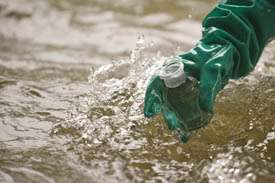Press release, 26 October 2012
Triclosan needs to be monitored
Leipzig. Researchers from Germany and Slovakia have pointed out that the chemical triclosan is one of those particularly harmful substances for the ecological status of rivers that are still not sufficiently monitored. With extensive monitoring conducted in the Elbe river basin that was more comprehensive than standard monitoring procedures, concentrations of the chemical at numerous test sites exceeded the predicted no-effect concentration (PNEC) for algal communities up to a factor of twelve. From the 500 river basin-specific pollutants investigated, triclosan (normally used as an anti-bacterial agent) ranked sixth as one of the most particularly harmful substances in Europe. It is therefore imperative to include this substance in routine monitoring programmes at the European scale, according to what researchers from the Helmholtz Centre for Environmental Research (UFZ) and the Environmental Institute in Slovakia have written in the journal „Environmental Science Pollution Research“.
 It is intended that the list of priority substances that have to be monitored by the authorities in Europe will be extended from its current 33 to 45 substances. The chemical triclosan is not one of these new candidates however.
It is intended that the list of priority substances that have to be monitored by the authorities in Europe will be extended from its current 33 to 45 substances. The chemical triclosan is not one of these new candidates however.
Photo: André Künzelmann/UFZ
It is intended that the list of priority substances that have to be monitored by the authorities in Europe will be extended from its current 33 to 45 substances. The chemical triclosan is not one of these new candidates however. This chemical has been on the market since 1972 and it was not until 1998 that the first serious effects were discovered. Until now triclosan has been used as an antibacterial and antifungal agent in personal care products (e.g. toothpaste) and sportswear. Scientists were also very concerned about the fact that nowadays triclosan cannot only be detected in organisms living in wastewater but also in human plasma and in breast milk. Therefore, harmful effects extending beyond water organisms cannot be excluded.
Approximately 350 tons of triclosan were used in the European Union in 2005. However, it is still not monitored in many parts of Europe. " Substances that are not on the list of priority substances do not have to be monitored and substances that are not monitored are usually not included on the list, because too little is known about their environmental relevance", Dr. Peter von der Ohe from the UFZ portrays this dilemma. Within the EU-research project MODELKEY scientists have therefore been closely examining several hundred pollutants in different European river catchment areas and have come up with suggestions on how the monitoring of rivers for chemicals could be improved.
Tilo Arnhold
Publications:
Peter Carsten von der Ohe, Mechthild Schmitt-Jansen, Jaroslav Slobodnik and Werner Brack (2012): Triclosan - the forgotten priority substance? Environ Sci Pollut Res. 19:585 – 591, DOI 10.1007/s11356-011-0580-7
http://dx.doi.org/10.1021/es3028378
The study was funded by the European Commission about the project MODELKEY and the German Research Foundation (DFG).
Franz, S., Altenburger R., Heilmeier H., Schmitt-Jansen M. (2008): What contributes to the sensitivity of microalgae to triclosan? Aquatic Toxicology, 90, 102-108.
http://dx.doi.org/10.1016/j.aquatox.2008.08.003
Further Information:
Helmholtz Centre for Environmental Research (UFZ)
Dr. Peter Carsten von der Ohe/ Dr. Mechthild Schmitt-Jansen/ Dr. Werner Brack
Phone: +49-341-235-1581, -1532, -1531
http://www.ufz.de/index.php?en=14838
http://www.ufz.de/index.php?en=17161
http://www.ufz.de/index.php?en=17477
or via
Tilo Arnhold (UFZ Press Office)
Phone: +49-341-235-1635
http://www.ufz.de/index.php?en=640
Links:
UFZ-Core Subject Area “Chemicals in the Environment / Health“:
http://www.ufz.de/index.php?en=30503
EU-Projekt MODELKEY:
At the Helmholtz Centre for Environmental Research (UFZ) scientists are researching the causes and consequences of far-reaching changes to the environment. They are concerned with water resources, biological diversity, the consequences of climate change and adaptability, environmental and biotechnologies, bioenergy, the behaviour of chemicals in the environment, their effect on health, modelling and social science issues. Their guiding theme: Our research contributes to the sustainable use of natural resources and helps to secure this basis for life over the long term under the effects of global change. The UFZ employs 1,000 people in Leipzig, Halle and Magdeburg. It is financed by the federal government and the federal states of Saxony and Saxony-Anhalt.
http://www.ufz.de/
The Helmholtz Association contributes towards solving major and pressing social, scientific and economic issues with scientific excellence in six research areas: Energy, Earth and Environment, Health, Key Technologies, Structure of Matter, Aeronautics, Aerospace and Transport. The Helmholtz Association is Germany’s largest scientific organisation with over 33,000 employees in 18 research centres and an annual budget of approximately 3.4 billion euros. Its work stands in the tradition of the naturalist Hermann von Helmholtz (1821-1894).
http://www.helmholtz.de
